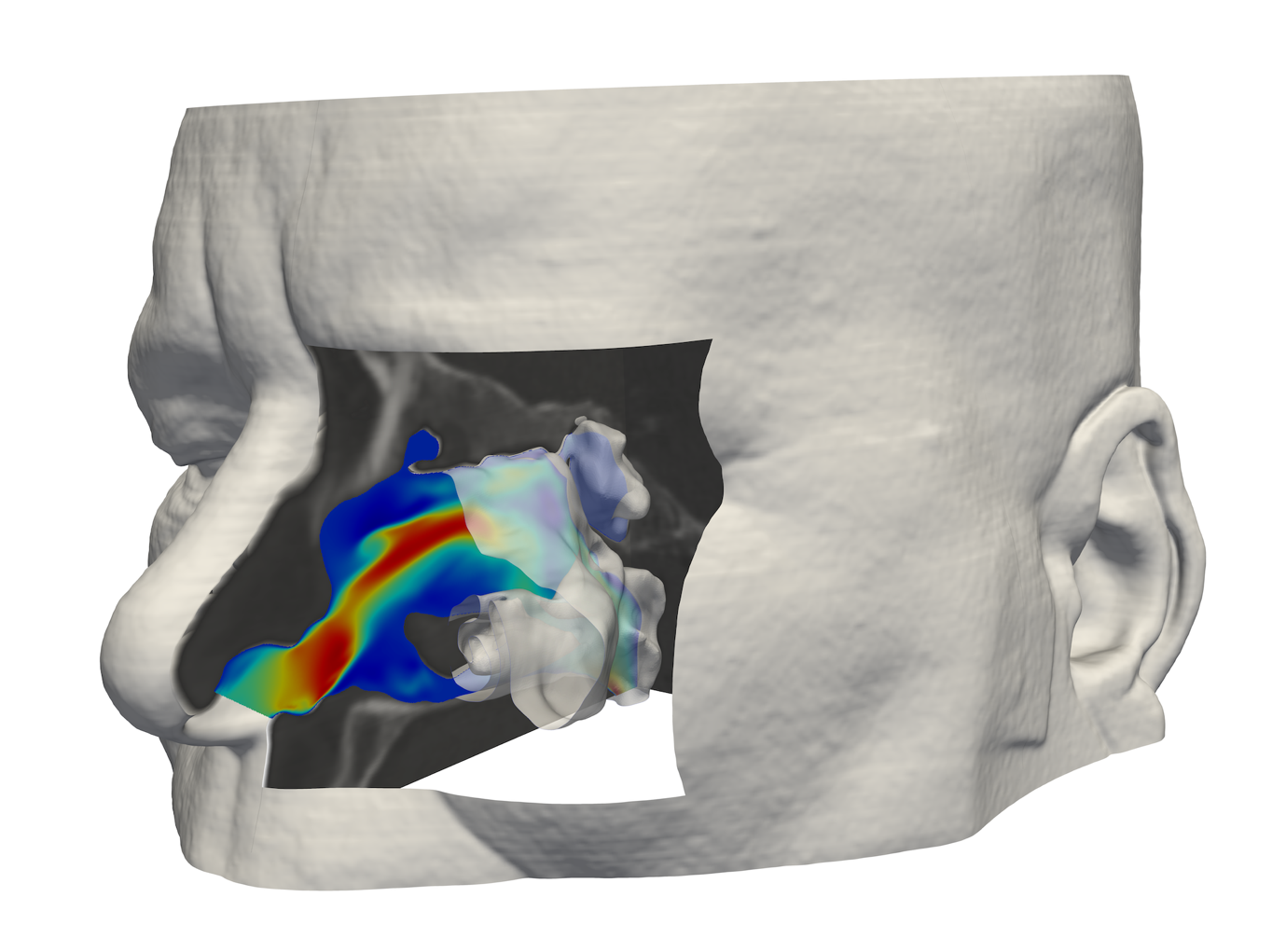
Figure: Simulation of the flow in the human nasal cavity. The geometry of the human head is opened to allow for a view on a cross-section of the simulated flow, the complex geometry of the nasal cavity, and the CT data used as base for this geometry. The color on the cross-section indicates the velocity magnitude of the air with increasing velocity from blue to red.
Written by Mario Rüttgers (Institute of Aerodynamics and Chair of Fluid Mechanics, RWTH Aachen University; Jülich Supercomputing Centre, Forschungzentrum Jülich GmbH) and Dr. Andreas Lintermann (Jülich Supercomputing Centre, Forschungzentrum Jülich GmbH). In collaboration with the University Hospitals Aachen and Salzburg.
A key challenge to effectively diagnose and treat pathologies in the field of rhinology is a physics-based evaluation of the human respiration. Nowadays’ methods, however, frequently rely solely on the analysis of medical images, visual inspection, or patient surveys. For example, in case of a septoplasty, a method to treat a deviated septum, a surgeon’s decision is mainly based on an evaluation of computer tomography (CT) images and more than 40% of the patients are not satisfied after a surgery [1]. Numerical flow simulations, see Figure 1, can help to evaluate respiration capabilities by analyzing fluid mechanical properties such as the pressure loss, which has to be overcome by the diaphragm to allow for comfortable breathing [2]. Obviously, corresponding workflows can only be applied efficiently in clinical environments if their usage is automated and results are accurate.
For more than five years, supercomputing resources at the Jülich Supercomputing Centre are used to develop methods to accurately analyze the flow and to automate the corresponding simulation pipeline. The pipeline uses CT data as input and provides results of flow simulations as output [2]. The automation incorporates machine learning (ML) methods into the pipeline that replace otherwise time-consuming manual or semi-manual steps. A combination of 2D and 3D convolutional neural networks (CNN) are employed to segment CT recordings into airway and other matter. A second CNN extracts the in- and outflow boundaries, which are necessary to impose relevant boundary conditions for the simulation. To evaluate the quality of a pipeline-generated nasal cavity, its’ geometrical and physical information are juxtaposed to results obtained from a semi-manual process supported by a medical professional. The area-averaged pressure loss and the temperature at cross-sections positioned along the geometries’ centerlines show negligible differences of less than 1%.
As the training of these CNNs is most efficient on GPUs, they have been trained on JURECA-DC’s GPU partition. Therefore, only a small number of GPUs has been necessary. In contrast, flow simulations with the m-AIA simulation framework (RWTH Aachen University) required up to 1,024 cores on the JURECA-DC Cluster module to reach a practical time to solution.
Furthermore, developments utilizing CPU and GPU resources on JURECA-DC are ongoing to (i) use automatically generated simulation results in combination with medical data to support the classification of pathologies, (ii) to optimize nasal cavity shapes, and (iii) to accelerate computations. For (i), CNNs learn from CT images and simulation results to detect and classify the severeness of a septoplasty. In (ii), a reinforcement learning algorithm is trained to modify the shape of a nasal cavity while maintaining two of the main functionalities of the nose: providing the lung with sufficient air and tempering it to body temperature. That is, after a modification the algorithm receives a feedback based on the change in pressure loss and temperature increase between in- and outflow region.
At the current stage of the project, the concept has successfully been applied to a simplified case, where the shape of a heated and perturbed 2D channel has been optimized [4]. Finally, for (iii), two different approaches are investigated. In the first approach, a CNN is trained to predict an averaged flow field inside the nasal cavity to efficiently initialize flow simulations. Since the size of a single batch is too large to be processed on a single GPU, the training is parallelized to utilize multiple GPUs. In the second approach, physics-informed neural networks (PINNs) are developed to efficiently predict the fluid mechanics of respiration. Since training data are extracted in patches, the bottleneck is not the size of a training batch, but the large amount of training data. The PINNs are therefore trained in parallel on multiple GPU nodes. In all cases (i) – (iii), flow simulations are conducted with the CPU-based simulation module of m-AIA on up to 1,024 cores, depending on the complexity of the case.
The developments also contribute to the European Center of Excellence in Exascale Computing “Research on AI- and Simulation-Based Engineering at Exascale” (CoE RAISE) , which aims at developing novel AI technologies along use cases coming from engineering and natural sciences to Exacale. In RAISE, AI approaches are generalized to allow for their wide applicability to whole set of applications. The research is also supported by the Helmholtz School for Data Science in Life, Earth, and Energy (HDS-LEE) and the Jülich Aachen Research Alliance Center for Simulation and Data Science (JARA-CASD) .
References:
[1] N. Toyserkani, T. Frisch, Are too many septal deviations operated on? a retrospective patient‘s satisfaction questionnaire with 11 years follow-up, Rhinology 50 (2012) 185–190. doi:10.4193/Rhino11.218.
[2] M. Rüttgers, M. Waldmann, W. Schröder, A. Lintermann: A machine-learning-based method for automatizing lattice-boltzmann simulations of respiratory flows, Journal of Applied Intelligence (2021, under review).
[3] A. Lintermann, M. Meinke, W. Schröder, Fluid mechanics based classification of the respiratory efficiency of several nasal cavities, Computers in Biology and Medicine 43 (11) (2013) 1833 – 1852. doi:10.1016/j.compbiomed.2013.09.003.
[4] M. Rüttgers, M. Waldmann, W. Schröder, A. Lintermann: Machine-learning-based control of perturbed and heated channel flows, ISC 2021, Lecture Notes in Computer Science (LNCS) (2021, accepted).
